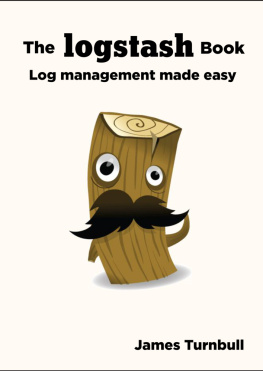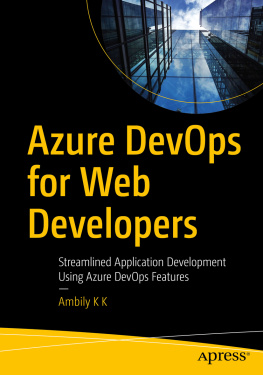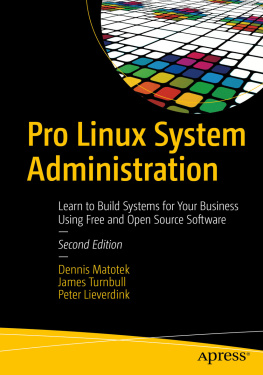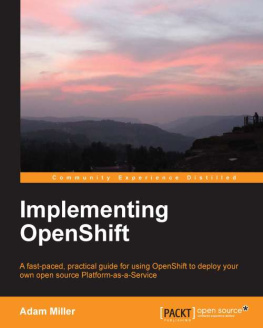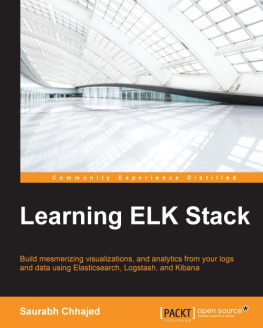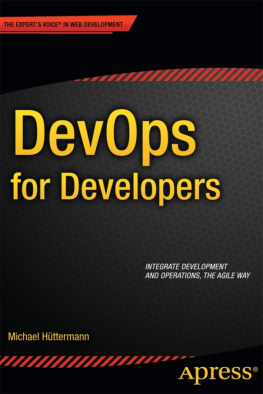Turnbull - The logstash book log management made easy
Here you can read online Turnbull - The logstash book log management made easy full text of the book (entire story) in english for free. Download pdf and epub, get meaning, cover and reviews about this ebook. year: 2015;2013, publisher: James Turnbull & Turnbull Press, genre: Home and family. Description of the work, (preface) as well as reviews are available. Best literature library LitArk.com created for fans of good reading and offers a wide selection of genres:
Romance novel
Science fiction
Adventure
Detective
Science
History
Home and family
Prose
Art
Politics
Computer
Non-fiction
Religion
Business
Children
Humor
Choose a favorite category and find really read worthwhile books. Enjoy immersion in the world of imagination, feel the emotions of the characters or learn something new for yourself, make an fascinating discovery.
- Book:The logstash book log management made easy
- Author:
- Publisher:James Turnbull & Turnbull Press
- Genre:
- Year:2015;2013
- Rating:5 / 5
- Favourites:Add to favourites
- Your mark:
- 100
- 1
- 2
- 3
- 4
- 5
The logstash book log management made easy: summary, description and annotation
We offer to read an annotation, description, summary or preface (depends on what the author of the book "The logstash book log management made easy" wrote himself). If you haven't found the necessary information about the book — write in the comments, we will try to find it.
The logstash book log management made easy — read online for free the complete book (whole text) full work
Below is the text of the book, divided by pages. System saving the place of the last page read, allows you to conveniently read the book "The logstash book log management made easy" online for free, without having to search again every time where you left off. Put a bookmark, and you can go to the page where you finished reading at any time.
Font size:
Interval:
Bookmark:

This book is designed for SysAdmins, operations staff, developers and DevOps who are interested in deploying a log management solution using the open source tool Logstash.
There is an expectation that the reader has basic Unix/Linux skills, and is familiar with the command line, editing files, installing packages, managing services, and basic networking.
- Jordan Sissel for writing Logstash and for all his assistance during the writing process.
- Rashid Khan for writing Kibana.
- Dean Wilson for his feedback on the book.
- Aaron Mildenstein for his Apache to JSON logging posts here and here.
- R.I. Pienaar for his excellent documentation on message queuing.
- The fine folks in the Freenode #logstash channel for being so helpful as I peppered them with questions, and
- Ruth Brown for only saying "Another book? WTF?" once, proof reading the book, making the cover page and for being awesome.
Jan-Piet Mens is an independent Unix/Linux consultant and sysadmin who's worked with Unix-systems since 1985. JP does odd bits of coding, and has architected infrastructure at major customers throughout Europe. One of his specialities is the Domain Name System and as such, he authored the book Alternative DNS Servers as well as a variety of other technical publications.
Paul Stack is a London based developer. He has a passion for continuous integration and continuous delivery and why they should be part of what developers do on a day to day basis. He believes that reliably delivering software is just as important as its development. He talks at conferences all over the world on this subject. Paul's passion for continuous delivery has led him to start working closer with operations staff and has led him to technologies like Logstash, Puppet and Chef.
has over 30 years experience in CAD design, computer support, network technologies, project management, business systems analysis for major Fortune 500 companies such as; Enron, Compaq, Koch Industries and Amoco Corp. He is currently employed as a Systems/Business Analyst at Kansas State University in Manhattan, KS. In his spare time he does Freelance Art and Technical Illustration as sole proprietor of Royce Art. He and his wife of 38 years are living in and restoring a 127 year old stone house nestled in the Flinthills of Kansas.
James is an author and open source geek. James authored the two books about Puppet (Pro Puppet and the earlier book about Puppet). He is also the author of three other books including Pro Linux System Administration, Pro Nagios 2.0, and Hardening Linux.
For a real job, James is VP of Engineering at Kickstarter. He was formerly at Docker as VP of Services and Support, Venmo as VP of Engineering and Puppet Labs as VP of Technical Operations. He likes food, wine, books, photography, and cats. He is not overly keen on long walks on the beach and holding hands.
This is an inline code statement.
This is a code block:
This is a code blockLong code strings are broken with .
You can find all the code and examples from the book on the website or you can check out the Git repo.
This book was written in Markdown with a large dollop of LaTeX. It was then converted to PDF and other formats using PanDoc (with some help from scripts written by the excellent folks who wrote Backbone.js on Rails).
Please email any Errata you find .
Kibana and Logstash are trademarks of Elasticsearch BV. Elasticsearch is a registered trademark of Elasticsearch BV.
This is version v1.4.3 (ad12e18) of The Logstash Book.
Some rights reserved. No part of this publication may be reproduced, stored in a retrieval system or transmitted in any form or by any means, electronic, mechanical or photocopying, recording, or otherwise for commercial purposes without the prior permission of the publisher.
This work is licensed under the Creative Commons Attribution-NonCommercial-NoDerivs 3.0 Unported License. To view a copy of this license, visit here.
Log management is often considered both a painful exercise and a dark art. Indeed, understanding good log management tends to be a slow and evolutionary process. In response to issues and problems, new SysAdmins are told: "Go look at the logs." A combination of cat, tail and grep (and often sed, awk or perl too) become their tools of choice to diagnose and identify problems in log and event data. They quickly become experts at command line and regular expression kung-fu: searching, parsing, stripping, manipulating and extracting data from a humble log event. It's a powerful and practical set of skills that strongly I recommend all SysAdmins learn.
Sadly, this solution does not scale. In most cases you have more than one host and multiple sources of log files. You may have tens, hundreds or even thousands of hosts. You run numerous, inter-connected applications and services across multiple locations and fabrics, both physically, virtually and in the cloud. In this world it quickly becomes apparent that logs from any one application, service or host are not enough to diagnose complex multi-tier issues.
To address this gap your log environment must evolve to become centralized. The tools of choice expand to include configuring applications to centrally log and services like rsyslog and syslog-ng to centrally deliver Syslog output. Events start flowing in and log servers to hold this data are built, consuming larger and larger amounts of storage.
But we're not done yet. The problem then turns from one of too little information to one of too much information and too little context. You have millions or billions of lines of logs to sift through. Those logs are produced in different timezones, formats and sometimes even in different languages. It becomes increasingly hard to sort through the growing streams of log data to find the data you need and harder again to correlate that data with other relevant events. Your growing collection of log events then becomes more of a burden than a benefit.
To solve this new issue you have to extend and expand your log management solution to include better parsing of logs, more elegant storage of logs (as flat files just don't cut it) and the addition of searching and indexing technology. What started as a simple grep through log files has become a major project in its own right. A project that has seen multiple investment iterations in several solutions (or multiple solutions and their integration) with a commensurate cost in effort and expense.
There is a better way.
Instead of walking this path, with the high cost of investment and the potential of evolutionary dead ends, you can start with Logstash. Logstash provides an integrated framework for log collection, centralization, parsing, storage and search.
Font size:
Interval:
Bookmark:
Similar books «The logstash book log management made easy»
Look at similar books to The logstash book log management made easy. We have selected literature similar in name and meaning in the hope of providing readers with more options to find new, interesting, not yet read works.
Discussion, reviews of the book The logstash book log management made easy and just readers' own opinions. Leave your comments, write what you think about the work, its meaning or the main characters. Specify what exactly you liked and what you didn't like, and why you think so.

